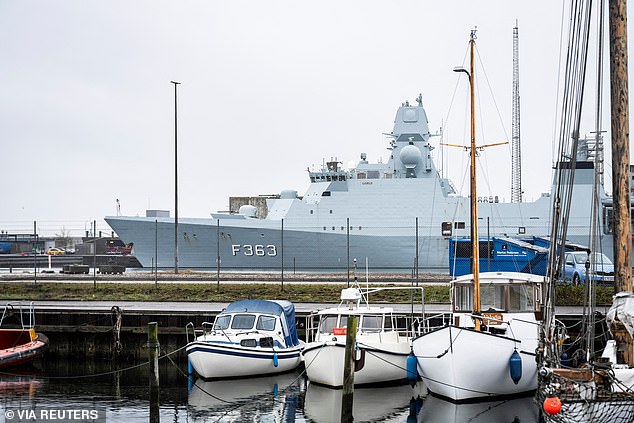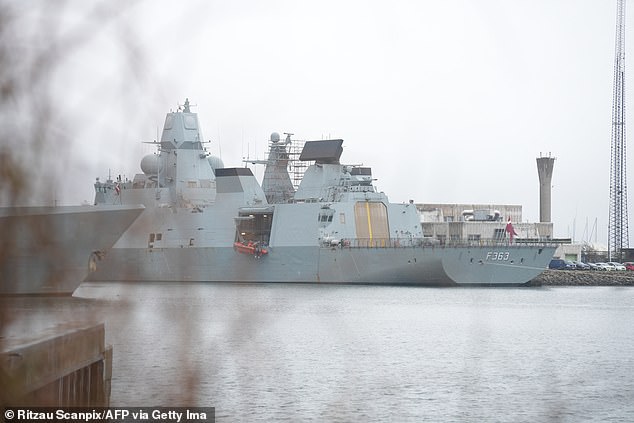- Denmark’s armed forces said the technical problem arose in a Harpoon missile on the frigate HDMS Niels Juel during tests docked at the Korsoer naval base.
<!–
<!–
<!– <!–
<!–
<!–
<!–
A Danish navy missile could be launched at any time due to a technical error, forcing the country to close an area of airspace and warn ships of a possible accidental attack.
Denmark’s armed forces said the technical problem arose in a Harpoon missile on the frigate HDMS Niels Juel during tests anchored at the Korsoer naval base, west of the capital Copenhagen.
“The launch vehicle, the booster, is activated and currently cannot be deactivated,” the military said in a statement.
The military said the missile is active, but only the booster is activated and there is no danger of the missile exploding or going further than the rocket booster can lift it.
However, an inadvertent launch could cause fragments to fall into Danish waters, posing a dangerous risk to other vehicles in the region.

Denmark’s armed forces said the technical problem arose in a Harpoon missile on the frigate HDMS Niels Juel (pictured Thursday) during tests docked at the Korsoer naval base.
It says: “Until the booster is deactivated, there is a risk that the missile will launch and fly several kilometers away.”
On its website, the Danish Maritime Authority said military exercises were taking place in the Storebaelt Strait between the islands of Zeeland and Funen.
The Great Belt sea route that separates the two islands and air traffic over it were closed between mid-afternoon and 8:00 p.m. (6:00 p.m. GMT).
The strait is a busy shipping lane connecting the Baltic Sea and the North Sea.
The danger zone is estimated to be 7 kilometers from Korsoer, at a height of approximately 1 km above sea level and not in the direction of the bridge and tunnel that crosses Storebaelt.
The link operator stated that there was no risk to road and rail traffic on the bridge.
Ships in the area were notified and asked to wait for the issue to be resolved, the military said, adding that airspace had also been closed.
The incident occurred a day after Defense Minister Troels Lund Poulsen fired Defense Chief Flemming Lentfer after having “lost confidence” in him.
This came after another Danish frigate, this time deployed to the Red Sea as part of a US-led operation, suffered a malfunction of its weapons systems when it was attacked by drones operated by Houthi militants last month.
The malfunction came to light on Thursday when the ship arrived in Denmark.
The failure, which until Thursday had only been reported by local defense outlet Olfi citing a confidential report from the ship’s captain, led the government to fire Flemming Lentfer on Wednesday.
Defense Minister Troels Lund Poulsen said the dismissal was the result of a breach of trust, after Lentfer did not fully inform the ministry about the March 9 incident when the frigate Iver Huitfeldt was attacked by Houthi militants.
Denmark, a founding member of the North Atlantic Treaty Organization, reduced its military capabilities after the end of the Cold War in the early 1990s.
The Nordic country has announced a significant increase in military spending to reach NATO’s target of 2% of gross domestic product, up from 1.4% last year, following the Russian invasion of Ukraine.


An inadvertent missile launch could cause fragments to fall into Danish waters, posing a dangerous risk to other vehicles in the region.
Thursday’s incident is not the first time Denmark has seen a defective missile cause chaos.
In 1982, a missile accidentally misfired from a Danish frigate during a drill and traveled 21 miles at low altitude before exploding.
The fireball and subsequent shock wave destroyed four unoccupied summer houses and caused minor damage to 130 other buildings in the area.
There were no injuries.

